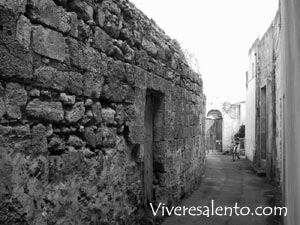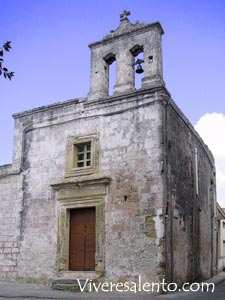|
|

| Inhabitants'
name: Disini
|
The civic coat
of arms of Diso consists of a lamb in a green lawn with a flag on the right
leg. The
 background
is blue. In the territory of this village people found an ancient menhir where
the old populations used to worship their Gods. We do not know exactly how and
when the village was founded but we can advance a couple of hypotheses. It
could have been founded by the Greeks after the destruction of Troia. According
to Mr Arditi the village was created in the 10th century when the
lords of Castro built some villas in this area because of its climate. The name
of the village was Disio. When the Turks invaded the Salento in 1480 and in
1536, those who survived those bloody persecutions, found shelter in Diso and
the village became bigger. The name of the village could derive from “dizos”, a
messapic word for fortitude. A third hypothesis is that the village was founded
by the Messapi in the 7th century B.C. and it was a fortified
village. until the 12th century the village was dominated by the
Romans, the Byzantines, the Longobards and the Saracens. The village was ruled
by Ruggero II, Count of Sicily, the Sangiovannis, the Bielottos, the De Righis,
the Sinerchias, the De background
is blue. In the territory of this village people found an ancient menhir where
the old populations used to worship their Gods. We do not know exactly how and
when the village was founded but we can advance a couple of hypotheses. It
could have been founded by the Greeks after the destruction of Troia. According
to Mr Arditi the village was created in the 10th century when the
lords of Castro built some villas in this area because of its climate. The name
of the village was Disio. When the Turks invaded the Salento in 1480 and in
1536, those who survived those bloody persecutions, found shelter in Diso and
the village became bigger. The name of the village could derive from “dizos”, a
messapic word for fortitude. A third hypothesis is that the village was founded
by the Messapi in the 7th century B.C. and it was a fortified
village. until the 12th century the village was dominated by the
Romans, the Byzantines, the Longobards and the Saracens. The village was ruled
by Ruggero II, Count of Sicily, the Sangiovannis, the Bielottos, the De Righis,
the Sinerchias, the De Francos, the Orsini Del Balzos, the Della Postas, the Gattinaras, the Ruiz De
Castros, the Lopez De Zunicas and finally the Rossis. Among the famous people of
Diso, we remember: Filippo Bottazzi was born in 1867,
he took his degree in medicine in 1893, then became teacher of Physiology in the
University of Genoa. He was Rector of the University of Naples, and received an
honorary degree from the Catholic University of Milan. He was elected mayor of
his village. he was an appreciated scientist and wrote several books. He died in
1941. Giuseppe Bono lived in the 17th century, he was a missionary
Capuchin and had to travel in many foreign countries and wrote several books on
Canonic Law. Pietrantonio Stasi was born in 1839 and was the beloved and
esteemed priest of the village. He was Antonio Bottazzi’s friend and spiritual
guide and wrote several poems that have been lost. He was a humble and cultured
priest and left all he had to the Maternal school of Diso. Paolo De Blasi lived
in the 16th century he belonged to a very rich family but he was
attracted by the monastic life so gave his patrimony to build the Convent of the
Capuchins. Later he became monk. Giuseppe Bottazzo was born in 1821 and learned
to draw from his uncle, Francesco Saverio Russo. He went to study in the Academy
of the Belle Arti of Naples, and specialized in frescos and painting. In Diso he
created a school for young talents and he made several wonderful works and is
considered one of the best 19th century artists of the Salento.
Francos, the Orsini Del Balzos, the Della Postas, the Gattinaras, the Ruiz De
Castros, the Lopez De Zunicas and finally the Rossis. Among the famous people of
Diso, we remember: Filippo Bottazzi was born in 1867,
he took his degree in medicine in 1893, then became teacher of Physiology in the
University of Genoa. He was Rector of the University of Naples, and received an
honorary degree from the Catholic University of Milan. He was elected mayor of
his village. he was an appreciated scientist and wrote several books. He died in
1941. Giuseppe Bono lived in the 17th century, he was a missionary
Capuchin and had to travel in many foreign countries and wrote several books on
Canonic Law. Pietrantonio Stasi was born in 1839 and was the beloved and
esteemed priest of the village. He was Antonio Bottazzi’s friend and spiritual
guide and wrote several poems that have been lost. He was a humble and cultured
priest and left all he had to the Maternal school of Diso. Paolo De Blasi lived
in the 16th century he belonged to a very rich family but he was
attracted by the monastic life so gave his patrimony to build the Convent of the
Capuchins. Later he became monk. Giuseppe Bottazzo was born in 1821 and learned
to draw from his uncle, Francesco Saverio Russo. He went to study in the Academy
of the Belle Arti of Naples, and specialized in frescos and painting. In Diso he
created a school for young talents and he made several wonderful works and is
considered one of the best 19th century artists of the Salento.
|